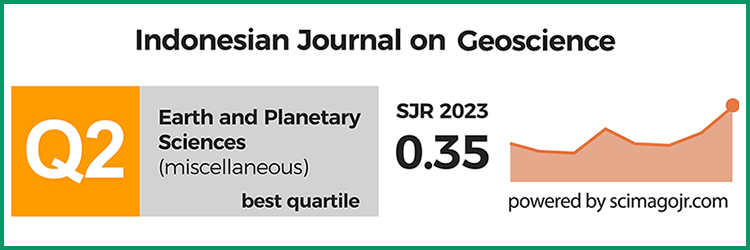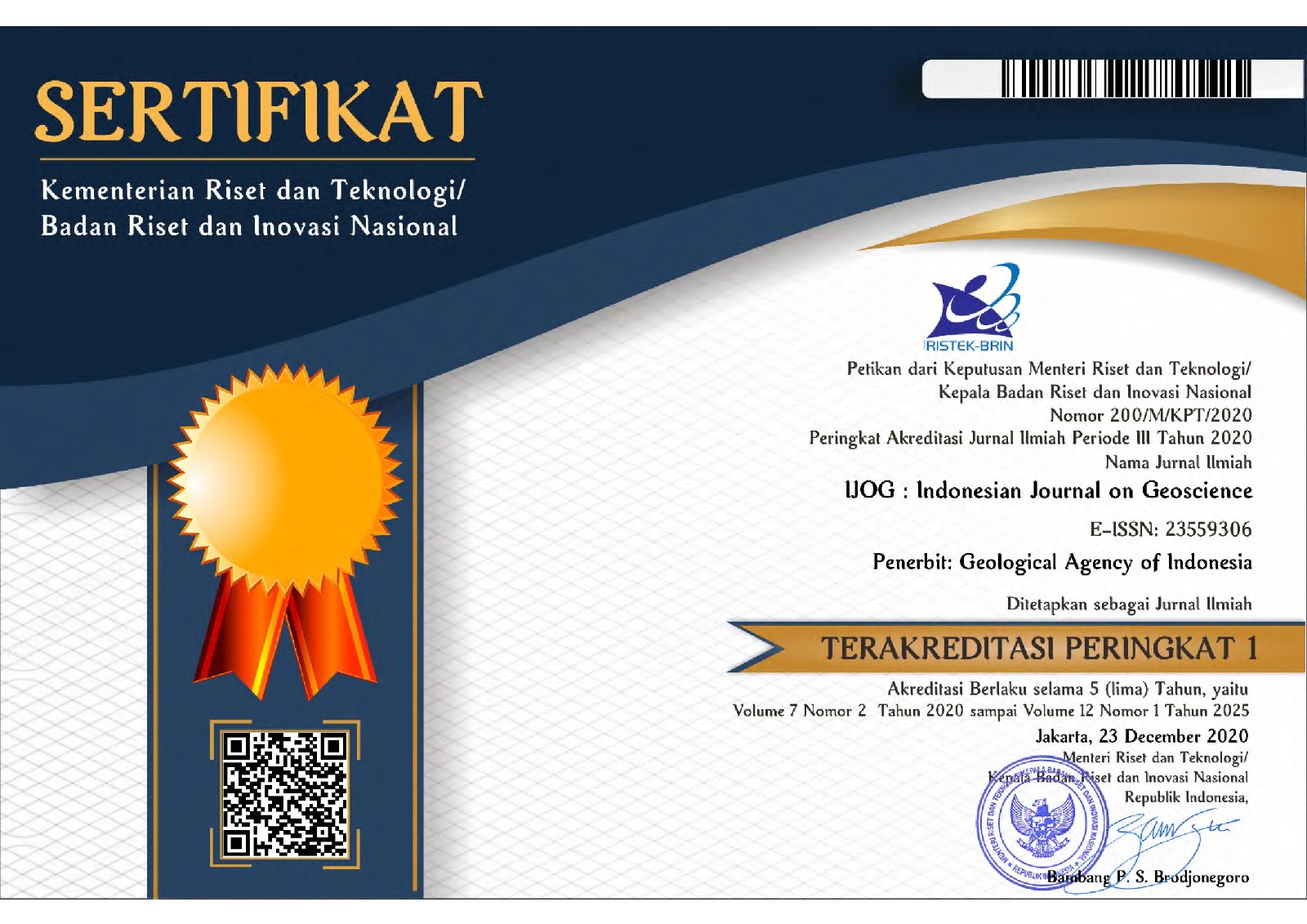An appraisal for the petroleum source rocks on oil seep and rock samples of the Tertiary Seblat and Lemau Formations, Bengkulu Basin
DOI:
https://doi.org/10.17014/ijog.4.1.43-55Keywords:
Source rock, oil seep, oil generation, Lemau Formation, Seblat Formation, Bengkulu BasinAbstract
https://dx.doi.org/10.17014/ijog.vol4no1.20095
The Tertiary Bengkulu Basin is known as a typical fore-arc basin, situated in southwest Sumatera. The basin initiated during Eocene-Oligocene times, accumulates the Lahat equivalent formation. The formation is is unconformably overlain by the Oligocene-Miocene Hulusimpang Formation consisting of volcanic rocks. It is then succeeded by siliciclastics and minor carbonates of the Early-Middle Miocene of Seblat Formation. Unconformably overlying the Seblat is siliciclastics of the Middle-Late Miocene Lemau Formation, then overlain by the Late Mio-Pliocene Simpangaur Formation. The basin succession is terminated by the sequence of volcanic rocks named as the Bintunan or Ranau Formation.
Geochemistry analyses (i.e. TOC, Rock-Eval and Gas Chromatography-Mass Spectrometry) conducted on selected outcrop and sub-crop samples, and one oil seep sample collected during field work, have given an appraisal to identify the nature of petroleum source rocks within the basin. The result of organic geochemistry and also organic petrology analyses indicates that potential source rocks may occurred in the stratigraphic succession of the basin. The Lahat equivalent formation, Seblat, and Lemau Formations may play an important role to generate oil within the Bengkulu Basin.
References
Amin, T.C., Kusnama, Rustandi, E., and Gafoer, S., 1994. Geological Map of Manna and Enggano Sheets, Sumatera, Scale 1 : 250.000. Geological Research and Development Centre, Bandung.
Bordenave, M.L., 1993. Applied Petroleum Geochemistry. Editions Technip, 27 Rue Ginoux 75737, Paris, cedex 15, 524pp.
Burley, S.D., Kantorowicz, J.D., and Waugh, B., 1987. Clastic Diagenesis. In: Beaumont E.A. and Foster, N.H. (comps.), Reservoirs II, sandstone, Treatise of Petroleum Geology Reprint Series No 4, American Association of Petroleum Geologists, p. 408-445.
Cook, A.C., 1982. The origin and petrology of organic matter in coals, oil shales and petroleum source-rocks. Geology Department, The University of Wollongong, 106pp.
Espitalie, J., Laporte, J.L., Madec, M., Marquis, F., Leplat, P., Paulet, J., and Boutefeu, A., 1977. Methode rapide de caracterisation des roches meres, de leur potentiel petrolier et de leur degre d’evolution. Revue Institut Francais Petrole, 32 (1), p.23-40.
Fildani, A., Hanson, A.D, Chen, Z., Moldowan, J.M., Graham, S.A., and Arriola, P.R., 2005. Geochemical characteristics of oil and source rocks and implications for petroleum systems, Talara basin, northwest Peru. American Association of Petroleum Geologists Bulletin, 89 (11), p.1519-1545.
Gafoer, S., Amin, T.C., and Pardede, R., 1992. Geologi Lembar Bengkulu, Sumatera, Sekala 1:250.000. Pusat Penelitian dan Pengembangan Geologi, Bandung.
Guntoro, A. and Djajadiharja Y.S., 2005. Tectonic Scenario of the Sumatra Fore-Arc Basin in Relation To the Formation of Petroleum Systems. International Conference on Geology, Geotechnology and Mineral Resources of Indochina (GEOINDO 2005) 28-30 November 2005, Khon Kaen, Thailand.
Heroux, Y., Chagnon, A., and Bertrand, R., 1979. Compilation and Correlation of Major Thermal Maturation Indicators. American Association of Petroleum Geologists Bulletin, 63(12), p. 2128-2144.
Heryanto, R., 2005. Laporan Penelitian Sumber Daya Hidrokarbon di Cekungan Bengkulu, Bengkulu. Pusat Penelitian dan Pengembangan Geologi, Balitbang ESDM, (Laporan Internal).
Heryanto, R., 2006a. Karakteristik Formasi Seblat di Daerah Bengkulu Selatan. Jurnal Sumber Daya Geologi, XVI (3), p.179-195.
Heryanto, R., 2006b. Provenance batupasir Formasi Lemau di Cekungan Bengkulu, Seminar Nasional Geologi Indonesia :”Dinamika dan Produknya”. Pusat Survey Geologi, Bandung, 5-6 Desember 2006.
Kantsler, A.J., Cook, A.C., and Smith, G.C., 1978. Rank variation, calculated paleotemperatures in understanding oil, gas occurrence. Oil and Gas Journal, 20, p.196-205.
Katz, B.J., 1983. Limitations of ‘Rock-Eval’ pyrolysis for typing organic matter. Organic Geochemistry, 4, p.195- 199.
Moldowan, J.M., Seifert, W.G., and Gallegos, E.J., 1985. Relationship between Petroleum Composition and Depositional Environment of Petroleum Source Rocks. American Association of Petroleum Geologists Bulletin, 69(8), p.1255-1268.
Peters, K.E., 1986. Guidelines for Evaluating Petroleum Source Rock Using Programmed Pyrolysis. American Association of Petroleum Geologists Bulletin, 70(3), p. 318-329.
Philp, R.P., 1985. Biological markers in fossil fuel production. In: Beaumont, E.A and Foster, N.H (Eds.), Geochemistry. Treatise of Petroleum Geology, Reprint Series No. 8., American Assocociation of Petroleum Geologists, Tulsa, Oklahoma 74101, U.S.A., p. 337-390.
Tissot, B. and Welte, D.H., 1984. Petroleum formation and occurrence. Springer-Verlag, Berlin-Heidelberg-New York-London-Paris-Tokyo. 2nd ed., 699pp
Yulihanto,B., Situmorang, B., Nurdjajadi, A., and Sain, B. 1995. Structural Analysis of the onshore Bengkulu Forearc Basin and Its Implication for Future Hydrocarbon Exploration activity. Proceedings 24th Indonesian Petroleum Association, Annual Convention, p.85-96.



















